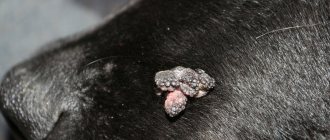Causes of lupus erythematosus in dogs
Systemic lupus erythematosus in dogs is a multisystem disease of an autoimmune nature with the formation of antibodies against autoantigens. The largest accumulation of specific formed complexes is diagnosed in the area of the glomerular zones of the renal structures, the synovial membranes of the bursae (joint bags), the skin and the blood vascular plexuses. There are a number of breeds that have a genetic predisposition to developing systemic lupus erythematosus. This list includes:
Note! The vast majority of systemic lupus is diagnosed in the German Shepherd breed. Characteristic signs of the disease appear over the age of 6 years. In this case, gender and physical characteristics do not play a role.
Modern veterinary medicine cannot clearly answer what causes lupus erythematosus. The vast majority of veterinarians are inclined to argue that the cause of the development of an autoimmune disease is a genetic predisposition to various inflammatory processes, as well as susceptibility to infectious lesions. The amount of ultraviolet radiation plays an important role in the development of systemic lupus erythematosus. In the course of scientific research, it was noted that animals living on the street are more often exposed to autoimmune diseases than their relatives, who are less likely to come into contact with direct ultraviolet rays.
Causes
An autoimmune pathological process may be due to the following reasons:
- Breed predisposition in collies, Irish setters, hounds, poodles, German and English shepherds, Afghan hounds;
- By gender – lupus erythematosus most often affects females;
- Age – the disease occurs in middle-aged dogs, 6-8 years old;
- Hereditary predisposition;
- Concomitant factors are decreased immunity due to infectious non-contagious serious diseases, long-term use of medications, and ultraviolet radiation.
Symptoms of lupus erythematosus
The characteristic signs of systemic lupus erythematosus in dogs depend on the type of antibodies produced by the body, as well as the location of the underlying lesions. The negative impact can be aggravated by genetic factors, as well as poor environmental conditions and infectious diseases. Often, the symptoms of lupus erythematosus begin to manifest themselves clearly after taking medications. With systemic lupus, characteristic changes are observed in:
Note! One of the most characteristic signs of the onset of lupus erythematosus is the presence of bleeding from the nasal cavity. Subsequently, hyperemia of the nasal mucosa and ulceration develop.
Symptoms
The clinical picture depends on the part of the body in which the immune complexes are localized and on the specification of autoantibodies. Various systems of the body produce their own picture of the disease.
Musculoskeletal system
Symptoms from this side are most often the following:
- pain and inflammation of the joint capsules;
- lameness;
- muscle weakness and soreness.
Leather
The following signs of the disease are visible on the skin:
- damage;
- ulcers at the junction of the skin and mucous membranes (near the lips, nose, anus). Abundant, extensive ulcers lead to loss of appetite and severe weight loss of the animal;
- baldness, loss of coat color, ulcers, redness.
Kidneys
Manifestations of the disease from the kidneys are the most dangerous, affecting the entire body as a whole:
- enlarged liver and kidneys;
- autoantibodies fight the cells responsible for blood clotting;
- inflammation of the lymph nodes;
- When lymphocytes attack, other body systems are also affected.
Important! Most often, the very first sign indicating developing lupus is frequent nosebleeds. After this, redness of the skin and ulceration of the mucocutaneous junctions appear.
Diagnosis and treatment
Autoimmune disease is quite difficult to diagnose and an accurate diagnosis requires a number of specific tests. If systemic lupus is suspected, a general blood test, biochemical examination and general urine analysis are prescribed. When making a diagnosis, it is important to accurately collect anamnesis - the onset of symptoms, the suddenness and nature of pathological changes.
Experienced doctors know that an accurate diagnosis requires testing for antinuclear bodies and double-stranded DNA antibodies. The Wasserman reaction is also carried out to test the blood for the presence of syphilis (for lupus erythematosus, the test is false positive). In some cases, samples of skin tissue or kidney structures are taken.
If at the time of contacting the veterinary clinic the dog is in serious condition, and the blood cells begin to rapidly disintegrate, the animal is hospitalized. For mild organ damage, outpatient treatment is prescribed. The purpose of the therapeutic regimen includes taking into account the form of the disease, stage of development, damage to internal organs and the age of the pet.
The animal is provided with maximum peace and comfort necessary to reduce the load on joints and bones, preventing their destruction. It is also necessary to reduce the time spent in direct sunlight by walking your pet only after sunset. The main treatment consists of the use of medications that alleviate the serious condition of the sick animal and prevent complications due to the autoimmune disease.
To reduce the immune response of the system, specific immunosuppressants and corticosteroid drugs are used. The affected areas of the skin are treated with anti-inflammatory hormonal ointments. For large areas of damage, injections of Prednisolone and vitamin E are prescribed (which allows faster restoration of damaged skin areas).
Treatment of systemic lupus erythematosus boils down to monitoring the pet’s condition, as well as eliminating the main symptoms. Animals with lupus can live for many years, but the sooner the owner contacts a qualified doctor when characteristic signs appear, the more effective the therapy will be.
Diagnosis of the disease
Lupus, like other autoimmune diseases, is difficult to diagnose. To identify it, a complete blood test, biochemical examination, and urinalysis are required. The veterinarian must know how long ago the signs have been appearing, what preceded them, and how suddenly they appeared.
On a note! The diagnosis can only be made after a full examination. It is impossible to judge the presence of such a serious and specific disease based only on external manifestations.
Prevention and surveillance
Systemic lupus erythematosus is an unpredictable disease, and treatment requires a long time. An experienced veterinarian should monitor your pet to note any improvements or deteriorations in its health. If lupus erythematosus is diagnosed, systematic monitoring by a doctor is required every 7 days. The further visit is determined by the doctor himself based on the clinical picture of the course of the disease.
For prevention purposes, it is necessary to conduct examinations of the animal and undergo the necessary tests once a year. It is also important to limit the dog’s exposure to the open sun (applies to all dogs). Animals diagnosed with lupus erythematosus are not recommended to be bred and have offspring from them.
Prevention
Owners of collies, Irish setters, hounds, poodles, German and English shepherds, and Afghan hounds are advised to walk their dogs in the morning and evening; if a diagnosis has been established, breeding and producing sick offspring is not allowed. If nosebleeds occur, you should immediately consult a specialist.
The causes of systemic lupus erythematosus are not fully understood today; the disease is difficult to diagnose in the early stages. It is advisable for the owner of a sick pet to prepare for long-term, sometimes life-long hormonal treatment with the manifestation of various side effects; in some cases, therapeutic measures are not successful. Early diagnosis and prescription of immunosuppressive drugs for mild forms of the disease contribute to the complete cure of your four-legged friend.
Similar articles:
- Pleurisy in dogs
- Cirrhosis of the liver in dogs
- Bedsores in dogs
- Inflammation of the eyelid in a dog (Blepharitis)
- Gum inflammation in dogs
- Intoxication in dogs
Causes of lupus erythematosus in dogs
Among the rare autoimmune diseases of domestic animals, lupus erythematosus in dogs is the most common and studied chronic pathology. The disease lies in the fact that the furry pet’s immune system malfunctions and begins to produce antibodies against the body’s own cells.
This situation leads to the development of inflammatory processes in internal organs, skin, and joints. It is in these tissues that pathological antigen-antibody immune complexes are most often formed, aimed at destroying viable cells of the animal.
Pathogenesis of lupus erythematosus
There is no consensus among veterinarians about the causes of autoimmune diseases in pets. Some experts believe that pathology is primarily caused by genetic predisposition. Thus, lupus erythematosus is most often diagnosed in breeds such as long-haired collies, Scottish and German shepherds, Afghan hounds, poodles, Irish setters, and hounds.
According to other veterinarians, factors such as:
Predisposing factors include gender and age. Thus, among females the disease is observed much more often than among males. According to the supervision of veterinary specialists, pets over 6-8 years old should be under the close attention of the owner. According to experienced dog breeders, prolonged stress can trigger a pathological mechanism in the immune system.
We recommend reading about the causes of pyoderma in dogs. From the article you will learn about the types of pathology, symptoms and methods of treating pyoderma in dogs, and the consequences for the animal. And here is more information about the causes and treatment of bald spots in dogs.
Lupus erythematosus, basic information about the disease
The disease affects all systems of the body, forcing the immune system to attack healthy cells and tissues, confusing them with harmful bacteria and viruses, trying to destroy them.
In dogs with lupus, a huge number of immune complexes are formed, stored in the section of the kidneys responsible for filtration, in the tissues lining the joint capsules of the wrists, knees and other joints, in the skin, in the blood vessels and other organs of the animal.
What factors increase the risk of lupus?
The cause of lupus is unknown in most cases. But there are a number of potential factors that can provoke the disease or contribute to its development:
Predisposed Breeds
Statistics show that some breeds are more likely to get lupus than others. This happens with the discoid form. But for the systemic form, the genetic factor is considered one of the most documented causes of the development of the disease.
The breeds that are most often listed as predisposed include:
Symptoms appear around 6 years of age, but can develop at any age and often relapse or go into remission throughout the animal's life.
Types of pathology and their symptoms
In veterinary practice, there are such main forms of autoimmune disorders as discoid, systemic and symmetrical lupus. Types of the disease differ in clinical presentation, gender and genetic predisposition.
Discoid
This clinical form of pathology is very rare. Veterinary experts do not see a relationship between gender and age, but there is a risk for breeds such as collies and German shepherds. Discoid lupus erythematosus in dogs manifests itself primarily as a violation of the normal pigmentation of the skin on the nose.
Then the pathological process is complicated by an inflammatory reaction. At the tip of the nose there is redness, swelling, erosion, and ulcers. As it dries, crusts form. Ulcers may bleed or fester if complicated by a bacterial infection. Less commonly, lesions are observed in the area of the auricle and oral cavity. With severe damage to the mucous membrane, the dog loses appetite and loses weight. In some cases, your pet experiences regular nosebleeds.
Discoid lupus erythematosus
According to the observation of veterinary therapists, animals living in hot climates are more likely to suffer from discoid lupus due to exposure to ultraviolet radiation on the body.
System
A severe disorder of the immune system is systemic lupus erythematosus in dogs. The cause of the disease is considered to be genetic predisposition, viral and bacterial infections, and illiterate use of immunosuppressants and hormonal drugs. With systemic lupus, many tissues of the body are affected.
Most often, the musculoskeletal system suffers from an attack of antibodies. The synovial membranes lining the articular surface are primarily affected. Clinically, this is expressed in their puffiness and swelling. The animal experiences severe pain. The owner may observe lameness and an unnatural gait. The dog avoids sudden movements, becomes lethargic and inactive. On palpation, muscle soreness is detected.
A) erosive dermatitis of the gums; B) ulcerative cortical dermatitis of the auricle
In addition to damage to the connective tissue of the joints, with systemic lupus, changes in the skin are observed. The dog develops alopecia. The skin becomes dry, covered with ulcers and crusts. As a rule, baldness affects the head, ears, tail and limbs. Hyperkeratosis may be observed in the paw area. Skin lesions are often complicated by bacterial infection, which leads to the development of severe pyoderma.
A malfunction of the immune system also leads to the development of anemia in a sick pet. Often, with systemic lupus, the owner also observes neurological disorders - convulsions, seizures.
Symmetrical
An autoimmune disease that primarily affects an animal's claws is called symmetrical lupus onychodystrophy. The disease is typical for German Shepherds and often affects females under the age of 6 years. Symptoms of lupus erythematosus in dogs include nail defects on all limbs.
Microflora joins the pathological process and inflammation develops. The animal is limping and constantly licking its paws. Soreness leads to lethargy, appetite decreases.
Diagnosis of an animal
Determining the autoimmune causes of health problems requires high professionalism from a veterinary specialist. Symptoms of the disease often appear sluggish and are similar to many pathologies. If lupus erythematosus in dogs is suspected, first of all, a thorough visual examination of the skin is performed. In this case, the doctor pays attention to the nature of the skin rashes, the presence of photodermatitis, and the symmetry of the lesions.
Equal importance is given to monitoring the pet’s behavior and the manifestation of neurological abnormalities.
If discoid lupus is suspected in a dog, it is advisable to undergo a skin biopsy. A general and biochemical blood test can help in establishing a diagnosis.
Thrombocytopenia, leukocytosis, or an increased number of lymphocytes may indicate an autoimmune pathology. Proteinuria is detected in the urine.
The cell test for lupus is often false negative, such as with leishmaniasis, making diagnosis difficult. Structural changes in the kidneys, characteristic of autoimmune pathology, are detected through ultrasound examination.
Differential diagnosis is carried out in relation to a number of diseases. First of all, demodicosis, leishmaniasis, and dermatophytosis are excluded in a furry patient. It is also necessary to conduct a bacteriological analysis for pyoderma and bacterial folliculitis.
Prevention and surveillance
The main preventive measure is the exclusion of animals with hereditary forms of the disease from the breeding program to prevent the spread of genetic disorders to offspring.
Animals predisposed to the disease should not be allowed outside at times when ultraviolet radiation is especially active. Sunlight is a strong predisposing factor for the disease. The dog's diet should be rich in protein, minerals and vitamins.
Sick animals require constant monitoring, since the treatment method involves long-term suppression of the immune system. During the period of active treatment, the animal is brought for a veterinary examination every 7 days. The frequency of further visits is determined by the attending physician.
Causes of the disease
"What is the reason?" - unfortunately, there is no clear answer to this question yet. Most experts believe that the cause is a genetic predisposition. The disease can be triggered by various external and internal factors: inflammatory processes in the body, infections, long exposure to the sun, frequent stress, fear, etc.
What breeds are at risk? These are collies, English shepherds, poodles, German shepherds, Afghan hounds. Most often, German shepherds that are under six years old get sick; bitches get sick more often.
Individuals who live on the street are at risk. A malfunction of the immune system can be a consequence of leukemia, bacterial or fungal disease. American scientists have found that lupus erythematosus in dogs can occur if they are fed moldy foods. But the treatment of the disease does not depend on the reasons that caused it, therefore, if the mechanism is started, all efforts must be directed towards treatment.
That is why it is so important to pay due attention to the health of your pets. Lupus-prone breeds should only be walked before sunrise or after sunset. They should not be subjected to too much physical activity; unjustified frequent stress can also provoke this disease. Animal feed should be varied, balanced and nutritious.
Diseases of the joints, kidneys and other organs must be diagnosed and treated in a timely manner, and due attention should be paid to immunity. If dogs get enough protein, minerals and vitamins, their immune system will function normally. The hereditary nature of this disease has been proven, so animals should not be allowed to reproduce.
Treatment of lupus erythematosus in dogs
When a pet is diagnosed with lupus erythematosus, the owner must understand that treatment will be long. First of all, a veterinarian will prescribe effective antibiotic therapy to prevent the development of purulent inflammation of the skin.
The antibacterial drug is selected individually. Drugs such as Cyclosporin A, Azathioprine, Mycophenolate, which have an immunosuppressive effect, are often used. Cutaneous forms of lupus are treated with hormonal ointments.
If the joints are affected, a pet with lupus is prescribed rest to relieve stress on the musculoskeletal system. The dog is kept indoors, excluding exposure to ultraviolet radiation as much as possible.
The main drugs that have a therapeutic effect in autoimmune pathology are immunosuppressants, for example, Tacrolimus. High doses of glucocorticosteroids, such as Prednisolone, significantly reduce the production of lymphocytes and immunoglobulins in the body of a sick animal, which is necessary for an autoimmune disease. The course of treatment is prescribed strictly individually and can range from 8 weeks to six months.
If an animal develops symmetrical lupus onychodystrophy, the damaged claw is surgically removed.
How to care for a sick dog
In addition to medications, your doctor may recommend additional treatments. Among them:
Do not forget that ultraviolet light, which contributes to the development of discoid lupus, will always be contraindicated for your animal. And you need to control the time he spends in the sun. Walking is recommended early in the morning or late in the evening. For animals kept in an enclosure, it must be completely shaded.
Did you know? No two cases of lupus present exactly the same way. This is a feature of autoimmune diseases.
The prognosis for the discoid form is usually good. Most dogs can control lupus with appropriate follow-up care and ongoing therapy. Signs can wax and wane, so you should always be prepared to deal with the next flare-up throughout your pet’s life.
The prognosis for recovery for animals with a systemic form of the disease is very cautious. It is difficult to treat, can progress and behave unpredictably. Therefore, long-term treatment is prescribed to animals with this form of lupus. But with prolonged suppression of the immune system, serious side effects can develop. This makes the prognosis for recovery very doubtful.
Forecast
Due to the complexity of diagnosis and the lack of a specific treatment regimen for an autoimmune disease, veterinary specialists make a cautious prognosis for a sick animal. According to the observation of therapists, 40% of four-legged friends die during the first year of the development of pathology. This occurs due to complications of the disease with a bacterial infection, chronic renal failure, the development of pneumonia and sepsis.
If there is a positive response of the body to the use of glucocorticoids, the prognosis is favorable.
We recommend reading about how to treat a dog's wound. From the article you will learn how to treat a superficial, lacerated, weeping and purulent wound, and what to do with an open deep wound. And here is more information about why arthritis develops in dogs and how to treat it.
Lupus erythematosus in dogs is a rare disorder of the immune system. The disease can affect both individual tissues, for example, the skin of the nose, and organs and systems - musculoskeletal, kidneys, lungs. The similarity of symptoms with many skin diseases and the lack of specific diagnostic methods make it difficult to detect the pathology in a timely manner.
Therapeutic techniques
There is no complete cure for the disease. Treatment can reduce autoimmune aggression and improve the general condition of the patient. The technique is chosen by the doctor depending on which organs and systems are involved in the pathological process. In advanced cases, the dog is placed in a hospital, and in milder cases, treatment is carried out on an outpatient basis.
Glucocorticosteroids (Prednisolone) are used to treat lupus erythematosus. The dose is selected individually, taking into account the patient’s age and the nature of the disease. In case of external manifestations, hormonal ointments are used. There are situations when lifelong use of hormonal therapy is prescribed.
Discoid lupus can be successfully treated with immune modulating drugs (Levamisole).
A sick dog must have a special lifestyle:
Treatment of the disease
The main thing is to prevent possible complications and try to alleviate the condition of the sick animal. Treatment depends on the type of lupus, the degree of damage to organs and systems, and the general condition of the patient. In cases of severe disease, and this most often happens with systemic lupus, the dog is subject to hospitalization and is prescribed complex treatment, including immunosuppressants.
But, in most cases, outpatient treatment is limited. We must not forget that each animal has its own individual characteristics; the doctor must take into account the severity of the disease, the stage at which it is located, the degree of damage, the age and health of the dog.
For a speedy recovery, it is very important to provide the animal with rest, good nutrition, and comfortable conditions; in this case, perhaps, the disease will not progress and the joint tissue will remain undamaged. Try to avoid stress, limit your pet's movements, perhaps he needs to be put in a cage for a while, this will not be very pleasant, but it is quite justified.
If the diagnosis is discoid lupus erythematosus, and the skin lesions are minor, then they are treated with hormonal ointment. If the degree of damage is large, injections of prednisolone and non-steroidal anti-inflammatory drugs are given. Vitamin E is prescribed, it promotes the regeneration of skin cells and prevents the development of secondary infections, and other drugs.
You need to be prepared for the fact that the treatment process will be quite complicated; it will take several months to treat your four-legged friend. But, if you strictly follow all the doctor’s recommendations, your pet will recover. Remember that this autoimmune disease is not a death sentence. With it, the animal can live for many more years. But the sooner you pay attention to the disease, the more effective the treatment will be, which means your pet will be able to remain healthy, and nothing will threaten its life.
Currently reading:
- Methods for killing scabies mites in dogs
- Thyroid dysfunction in dogs (hypothyroidism)
- Games to choose for training a dog
- All the reasons why a dog starts to lose coordination
Clinical signs
Clinical signs of SLE vary depending on the number of body systems affected. In classic cases, clinical signs occur periodically, and often the disease becomes chronic. However, some animals present with acute clinical signs.
The most common complaint in dogs is gait disturbance, most commonly in the form of intermittent claudication. These findings indicate polyarthritis or polymyositis. There may be swelling or tenderness of the joints upon palpation, as well as myalgia, accompanied by or without a decrease in muscle mass.
Physical examination may reveal other abnormalities, such as skin lesions without a specific distribution. The most commonly affected areas are the limbs, torso, head, ears, mucocutaneous border and muzzle. These lesions may be in the form of erythema, ulcers, crusts, exudation or alopecia.
Ulcers form on the mucocutaneous border and in the oral mucosa. Erosive lesions appear in areas with thin skin, such as the axilla, ventral abdomen, and periorbital region. In dogs, clinical signs can be divided into major and minor (Table 1).
| Table 1. Diagnosis of systemic lupus erythematosus* | ||
| Main signs | Minor signs | Serology |
| Skin lesions Polyarthritis Hemolytic anemia Glomerulonephritis Polymyositis Leukopenia Thrombocytopenia | Fever of unknown origin Signs of central nervous system damage, convulsions Oral ulcers Lymphadenopathy Pericarditis Pleurisy | Antinuclear Antibodies (ANA) Cell Dissection for Lupus Erythematosus |
| * Well-defined systemic lupus erythematosus (SLE): two main features with positive serology; one main feature; two minor signs with positive serology. Probable SLE: one major feature with positive serology; two main signs with negative serology. WorksGorman NT, Werner LL: Immune-mediated diseases of the dog and cat: I. Basic concepts on the systemic immune-mediated diseases. Br Vet J 142:395, 1986, reprinted with permission. | ||
We suggest you read: Why cats sleep at the feet of a person next to him
Autoimmune dermatoses in dogs and cats
Autoimmune diseases
– a group of diseases that are characterized by an excessive reaction of the immune system to the body’s own cells and tissues, the so-called target cells.
Dermatoses diseases
of the pemphigoid complex (pemphigus foliaceus,
pemphigus vulgaris
, bullous pemphigoid, pemphigus vegetans and erythematous), systemic
lupus erythematosus
, discoid lupus erythematosus, auricular polychondritis, vasculitis, cold agglutinin disease,
vitiligo
.
In this disease, the target cells are the intercellular substance in the epidermis
.
As a result, a split occurs between the papillary and stratum corneum. Externally, this process is manifested by the formation of pustules
.
Pustules are usually localized in the area of the muzzle and ears, large in size, symmetrically located. In the absence of pustules, an incorrect diagnosis of allergic dermatitis
.
Systemic reactions may occur - anorexia, fever, apathy. The diagnosis is confirmed with a skin biopsy
.
In this disease, the splitting occurs mainly between the basal and stratum corneum of the epidermis. Clinically, pemphigus vulgaris manifests itself as vesicles and ulcerations on the oral mucosa and mucocutaneous border. Since pemphigus vulgaris occurs with the appearance of ulcers in the oral cavity
, the disease is often severe and can threaten the life of the animal. If pemphigus vulgaris is suspected, calicivirus in cats and ulcerative gingivitis should be excluded. The diagnosis is made based on histological examination of the skin. This disease is characterized by the presence of plasma cells on the basement membrane, which are located in the form of “gravestones”.
Symmetrical lupus onychodystrophy
Symmetrical lupus onychodystrophy occurs due to disorders in the immune system. German Shepherds are most susceptible to this disease.
As you can see in the photo, with this type of lupus in dogs there is a defect in the claws on all four paws:
There are no other skin lesions. Often this lupus in dogs is accompanied by a disease such as paronychia.
When making a diagnosis, it is important to exclude systemic lupus erythematosus, onychomycosis and pemphigus vulgaris.
It is recommended to remove all claws under general anesthesia. The claws must be carefully pulled out using hemostats, taking care not to leave any part of the claw in its bed.
If an infection occurs (based on laboratory results), antibacterial therapy is indicated for the treatment of this type of lupus in dogs (for example, cephalexin at a dosage of 20 mg/kg 2 times a day). The duration of treatment is 10-14 days.
After declawing, it is recommended to use prednisolone at a dosage of 1 mg/kg every other day and omega-6 and omega-3 fatty acids.
Relapses of the disease may occur.











